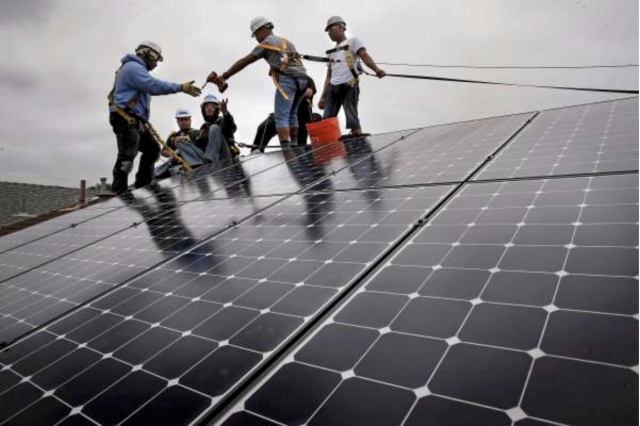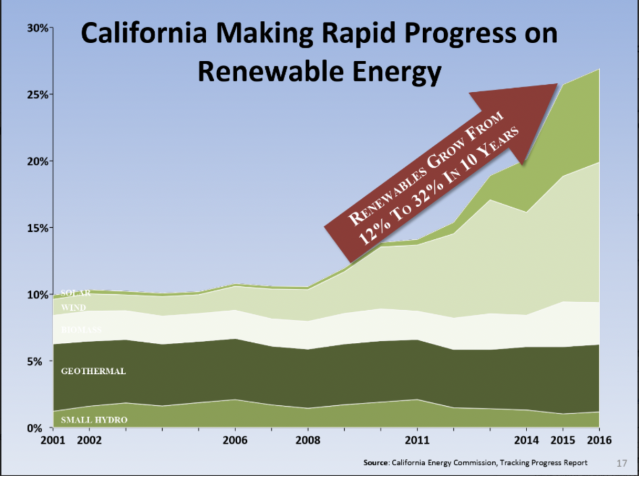NEWS Op Ed in the San Francisco Chronicle
Green energy is gold for California and the US
For the article pdf, click here.
I am a physicist, and an energy and sustainability science researcher, and I live in California because of its penchant for not just setting but actually achieving big goals and adopting bold visions others may consider too ambitious. What California proposes, we research, debate and then accomplish. In fact, we often exceed the goals skeptics have deemed unmeetable. This is why I believe that California should — and ultimately will — pass into law the “100 Percent Clean Energy Act” (Senate Bill 100), which would establish a bold goal of 100 percent clean, zero-carbon electricity by 2045.
To fully appreciate the multifaceted benefits of SB100 for California and the country, a bit of history is needed.
Thanks to a law California passed in 2002 (the Renewables Portfolio Standard), the state has nearly tripled its use of electricity produced from renewable resources. Today, solar, wind, biomass, and geothermal power (the “renewables”) meet more than a third of the state’s electricity demand — up from 12 percent in only a decade.
Just last month, the California Air Resources Board announced that the state has met its goal of reducing greenhouse gas emissions below 1990 levels in 2016 — a full four years ahead of its 2020 deadline. Our system of renewable electricity generation is a key driver of that success.
In fact, the state Public Utilities Commission has estimated that California will probably meet its goal of producing 50 percent of electricity from renewable resources well ahead of the 2030 deadline. California and New York state have emerged as national leaders in energy efficiency and in setting and meeting clean energy targets that together have kept utility rates low. Financial benefits follow directly: The majority of all U.S. “clean tech” investment has come through these two states.
This transition has been a net job generator: California now has more people employed in the solar energy industry than in traditional utilities. For 15 years, I have been tracking job creation in the clean energy sector, where today we find two to four times more jobs in solar, wind, sustainable biomass, efficiency and energy storage than in any fossil-fuel sector. The price of wind- and solar-generated energy has dropped faster than expected and is cost-competitive or cheaper than the cost of building new fossil-fuel-powered plants. The fact that the best solar and wind energy projects are actually cheaper than natural gas has been an enormous surprise to many not following the sector closely.
Next up is for California to establish the bold new goal to power our state with 100 percent zero-carbon energy by 2045. SB100 would mandate that 60 percent of our electricity demand be met with renewable sources, and allows flexibility for how the other 40 percent might be met via additional renewables, existing large hydropower, or other clean energy sources — including new technologies. Some critics note that SB100 does not explicitly prohibit carbon emissions if we also capture the carbon. This is less useful — and more expensive — in my analysis than a mixture of zero carbon sources and energy storage, but permitting the flexibility is a broader, more inclusive mandate that does not try to pick specific winners and losers.
More synergies between clean energy and jobs for Californians exist here, too. The same wave of innovation we saw in solar energy — where California played key research and deployment roles — we now are seeing in the energy storage industry. California is leading this charge, too, and stands to profit in revenue and more jobs.
Big transformational goals are proven drivers of innovation. In 2005, the Legislature passed legislation that set a target of 1 million solar rooftops by 2020. At the time, the typical response was that it was too ambitious, and more details were needed. Today, California has close to 700,000 solar rooftops, well on the way to the goal. Each rooftop saves the homeowner money, too, as solar power costs pencil out at under 5 cents per kilowatt-hour, while utility-generated power retails at more than four times that cost. Despite some legal and regulatory battles, residential rooftop solar saves utilities money, too, as rooftops are generating power during the day — i.e., during the time of the peak of power demand. Any extra generation can be put into storage.
Since 1999 I have served as a coordinating lead author for the Intergovernmental Panel on Climate Change, where scientists have recognized that clean and renewable energy sources must become the dominant source of electricity powering buildings, industry and transportation if we are to avoid the worst climate change effects that threaten California. As the world’s fifth-largest economy, California will gain economically as we develop new technologies and services that others will need as they work toward global climate goals. Current political troubles aside, this is where the United States must go.
As the world will see at the Global Climate Action Summit that California will host Sept. 12–14 in San Francisco, we have demonstrated the capacity and leadership needed to achieve big goals. SB100 sets a new goal for a clean, healthy and profitable energy system. With the global clean energy market growing far faster that the fossil-fuel sector, what California is doing is a good business decision for the state and the nation.
In The San Francisco Chronicle, August 17, 2018. Click here for the direct link.
To access from the RAEL publications pages, click here.
To access on the Berkeley Blog, click here.
Daniel M. Kammen is the founding director of the Renewable and Appropriate Energy Laboratory and director of the Center for Environmental Public Policy at UC Berkeley. Kammen has served as the chief technical specialist for renewable energy at the World Bank, and science envoy for the U.S. State Department. Twitter: @dan_kammen To comment, submit your letter to the editor at SFChronicle.com/letters.


You must be logged in to post a comment.